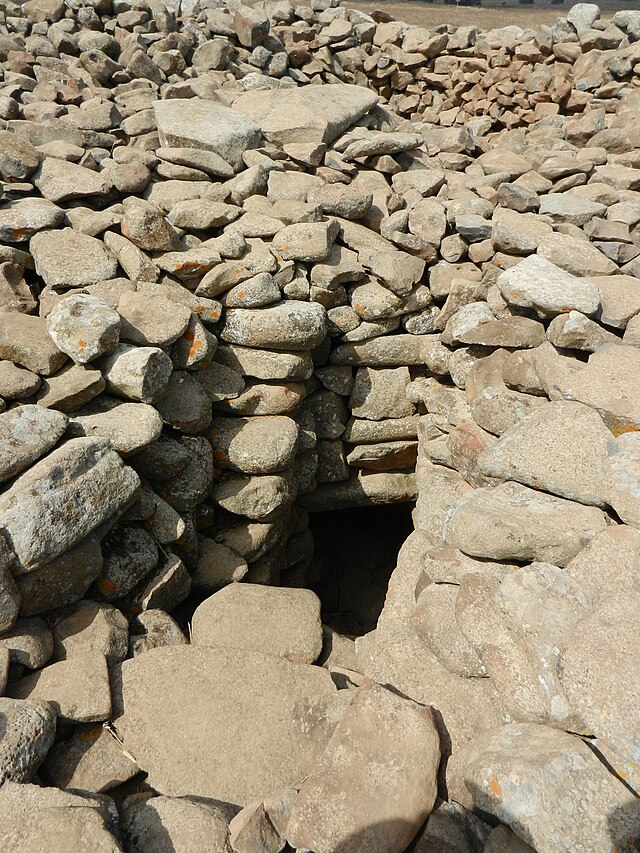Loading AI tools
Stone-age monument in the Golan Heights From Wikipedia, the free encyclopedia
Rujm el-Hiri (Arabic: رجم الهري, romanized: Rujm al-Hīrī; Hebrew: גִּלְגַּל רְפָאִים, romanized: Gilgal Refaʾim ) is an ancient megalith consisting of concentric circles of stone with a tumulus at center.[1] It is located in the Israeli-occupied portion of the Golan Heights some 16 kilometres (9.9 mi) east of the coast of the Sea of Galilee, in the middle of a large plateau covered with hundreds of dolmens.[1][2]
 Rujm el-Hiri – Gilgal Refaim | |
| Alternative name | Rogem Hiri, Galgal Refaim |
|---|---|
| Location | Golan Heights |
| Coordinates | 32.908705°N 35.800705°E |
Made up of more than 42,000 basalt rocks arranged in concentric circles, Rujm al-Hiri has a mound 15 feet (4.6 m) tall at its center.[2] Some circles are complete, others incomplete. The outermost wall is 520 feet (160 m) in diameter and 8 feet (2.4 m) high. The establishment of the site, and other nearby ancient settlements, is dated by archaeologists to the Early Bronze Age II period (3000–2700 BCE).[1]
Since excavations have yielded very few material remains, Israeli archeologists theorize that the site was not a defensive position or a residential quarter but most likely a ritual center featuring ritual activity to placate the gods,[3] or possibly linked to the cult of the dead.[4] However, there is no consensus regarding its function, as no similar structure has been found in the Near East.[5]
The name Rujm el-Hiri, "stone heap of the wildcat",[2] was originally taken from Syrian maps.[6] The term rujm in Arabic (pl. rujum; Hebrew: rogem) can also refer to a tumulus, a heap of stones underneath which human burial space was located.[1] The name is sometimes romanized as Rujm Hiri or Rujum al-Hiri.
Rogem Hiri is a Modern Hebrew of the Arabic name Rujm el-Hiri.[2] A modern Hebrew name used for the site is Gilgal Refaʾim "Wheel of Spirits" or "Wheel of Ghosts" as refa'im means "ghosts" or "spirits".[7][8]

The site's size and location, on a wide plateau which is also scattered with hundreds of dolmens, means that an aerial perspective is necessary to see the complete layout.[1] The site was made from Basalt rocks, common in the Golan Heights due to the region's history of volcanic activity. It is made from 37,500-40,000 tons[9] of partly worked stone stacked up to 2 meters (6.6 ft) high.[10] It was estimated by Freikman that the transportation and building of the massive monument would have required more than 25,000 working days.[9]
The remains consist of a large circle (slightly oval) of basalt rocks containing four smaller concentric circles, each getting progressively thinner; some are complete, others incomplete.[11] The walls of the circles are connected by irregularly placed smaller stone walls perpendicular to the circles.[11]
The central tumulus is built from smaller rocks and is thought to have been constructed after the surrounding walls.[10] Connecting to it are four main stone walls. The first wall, shaped like a semicircle, is 50 m in diameter and 1.5 m wide. That wall is connected to a second one, an almost complete circle 90 m in diameter. The third wall is a full circle, 110 m in diameter and 2.6 m wide. The fourth and outermost wall is the largest: 150 m in diameter and 3.2 m wide.
A central tumulus 65 feet (20 m) in diameter and 15 feet (4.6 m) high is surrounded by concentric circles, the outermost of which is 520 feet (160 m) in diameter and 8 feet (2.4 m) high.[1] Two entrances to the site face the northeast (29 meters (95 ft) wide) and southeast (26 meters (85 ft) wide).[1][2] The northeast entrance leads to an accessway 20 feet (6.1 m) long leading to the center of the circle which seems to point in the general direction of the June solstice sunrise.[2][10] The axis of the tomb discovered at the site's center is similarly aligned.[10]
The site was cataloged during an archaeological survey carried out in 1967–1968 by Shmarya Guttman and Claire Epstein.[1] The site is probably the source of the legends about "a remnant of the giants" or Rephaim of Og.[12] The surveyors used Syrian maps, and a Syrian triangulation post was found on top of its cairn.[6] After this initial study, serious archaeological excavations commenced in the 1980s under Israeli professors Moshe Kochavi and Yoni Mizrachi, as part of the Land of Geshur Archaeological Project.[13][14]
In 2007, the site was excavated by Yosef Garfinkel and Michael Freikman of the Hebrew University of Jerusalem. Freikman returned in the summer of 2010 for further investigation of the site's date and function.[17] Freikman believes that the tomb in the center was built at the same time as the rings. Tomb robbers looted the remains, which included jewelry and weapons, but based on the discovery of one Chalcolithic pin dropped in a passageway, Freikman's theory is that the tomb was the centerpiece of the rings.[18]
New Age movements advocating a return to nature gather at the site on the June solstice and on the equinoxes to view the first rays of the sun shine through the rocks. [citation needed]
The Golan Trail, a marked 130-kilometer walking trail that stretches along the whole length of the Golan Heights, passes Gilgal Refa'im.[19]
Seamless Wikipedia browsing. On steroids.
Every time you click a link to Wikipedia, Wiktionary or Wikiquote in your browser's search results, it will show the modern Wikiwand interface.
Wikiwand extension is a five stars, simple, with minimum permission required to keep your browsing private, safe and transparent.